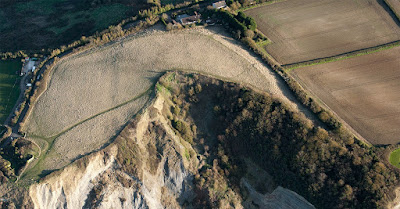Daw's, Dane's or Dart's Castle, Somerset, England
Having come to the conclusion (see https://mistshadows.blogspot.com/2020/04/a-new-identification-of-arthurs-mother.html ) that Arthur's mother owes her name to Carne (rock, rock outcrop) at Domellick, I reflected further on why Geoffrey of Monmouth placed Arthur's birth at Tintagel.
We must begin with the meaning of Tintagel. It is composed of two Cornish elements, Din for 'fort', and tagel, cognate with Welsh tagell, 'throat, windpipe, gullet.'
Now we can go to the Life of St. Carantoc (Version One), where Arthur's land of Carrum (or Carrov) is being ravaged by a 'serpentem validissimum, ingentem, terribiliem', i.e. a strong and terrible dragon. Carrov is modern-day Carhampton. This place is not far from the ostium Guellit, the mouth of the stream at Williton. These locations are in close proximity to Arthur's fort of Dindraithou, now called variously Daw's or Dane's or Dart's Castle (https://mistshadows.blogspot.com/2017/12/dindraithou-darts-castle-at-watchet.html).
What seems pretty obvious to me is that Geoffrey of Monmouth utilized this saint's Life in the following way: he took the terrible dragon and made that monster into Uther Pendragon. Carrum or Carentone (1086 DB) is (see Mills) from OE carr, dative plural carrum, plus tun for "farm at the place of the rocks." Guellit was associated with the French word for throat or windpipe, our word 'gullet':
gullet (n.)
"passage from the mouth of an animal to the stomach," c. 1300 (as a surname), from Old French golet "neck (of a bottle); gutter; bay, creek," diminutive of gole "throat, neck" (Modern French gueule), from Latin gula "throat," also "appetite," which is related to gluttire "to gulp down, devour," glutto "a glutton." De Vaan writes, "We seem to be dealing with an onomatopoeic formation of the form *gul- / *glu-." Compare Old English ceole "throat;" Old Church Slavonic glutu "gullet," Russian glot "draught, gulp;" Old Irish gelim "I devour."
It was then a simple matter for the author to find Tintagel, whose second element seemed to be identical in meaning to Guellit.
At first glance this may all seem a bit far-fetched. But we must remember that first and foremost Geoffrey was not only a creative genius, but a master of synthesis. It was probably not at all difficult for him to see in the terrible dragon of the St. Carantoc Life the terrible chief dragon who was Arthur's father. Or to identify Carrum/Caren- in one place with Carne in another. Or to see in a Celtic name Guellit the French form of a word whose meaning was contained in Tintagel.
Not sure whether anyone else will find this convincing. As for myself, I no longer see any need to pay attention to Tintagel as a potential birthplace of Arthur. Nor should we look to Dindraithou as an alternative. I've made this last clear by consulting the archaeological reports on Dart's Castle, who have shown it to be an English construction designed to protect the coast against Viking marauders.

No comments:
Post a Comment
Note: Only a member of this blog may post a comment.